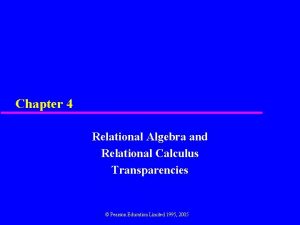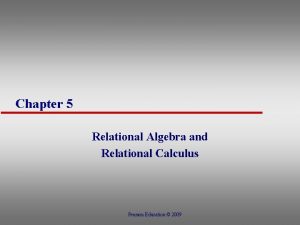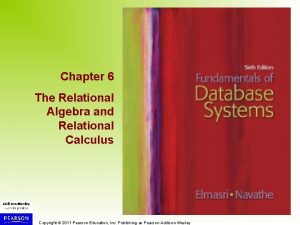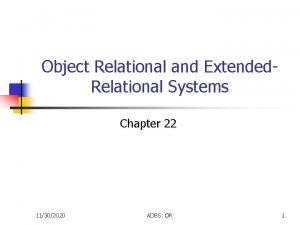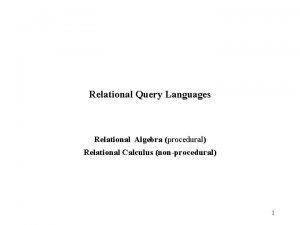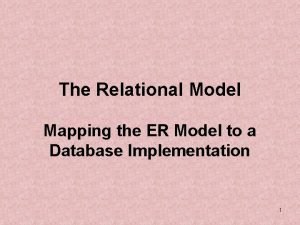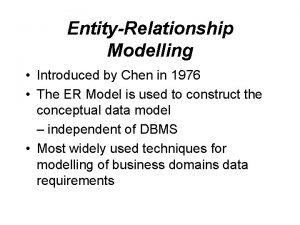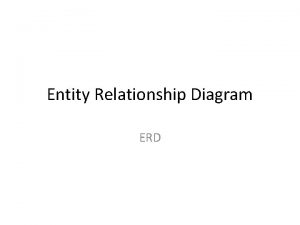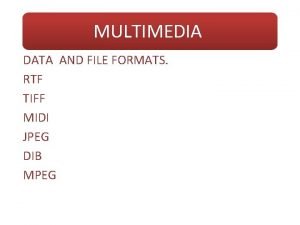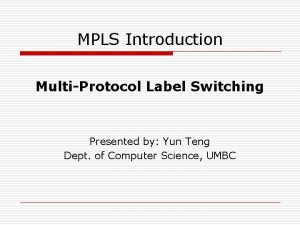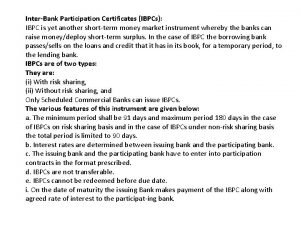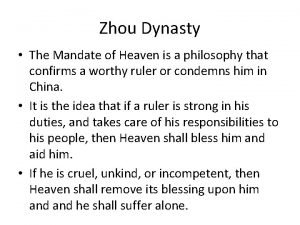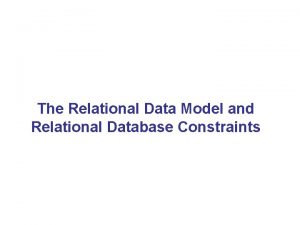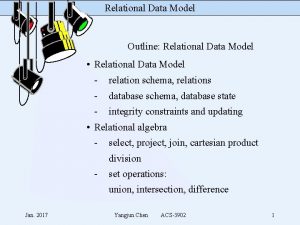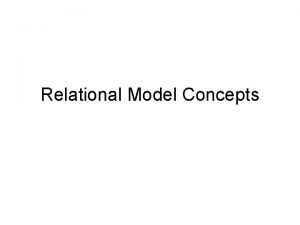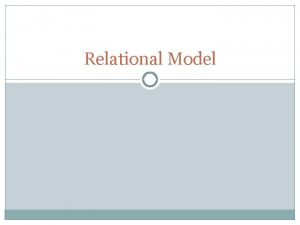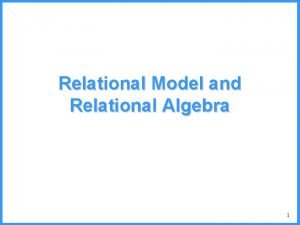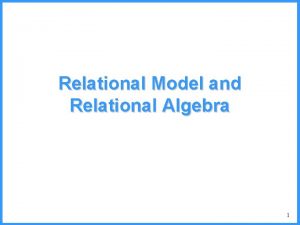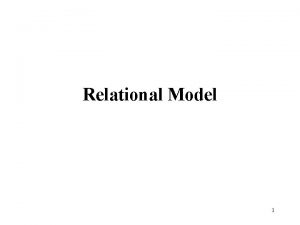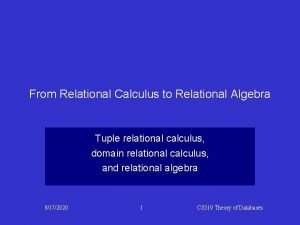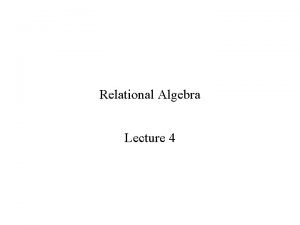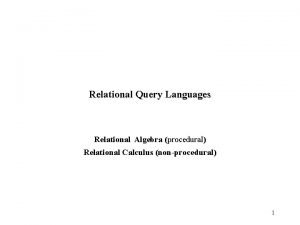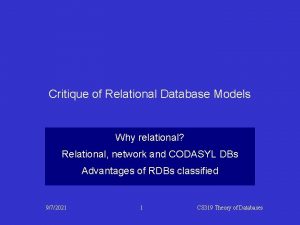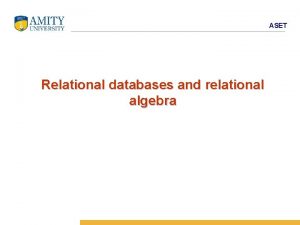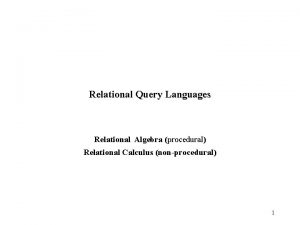The Relational Model The Relational Model Introduction Introduced











































- Slides: 43

The Relational Model

The Relational Model • Introduction • Introduced by Ted Codd at IBM Research in 1970 • The relational model represents data in the form of table. • Main concept of this model is mathematical relation ie the mapping between sets • Relation is some kind of association or link between sets

The Relational Model • • Introduction Relational database is collection of relations Relation represents a Table. Contains different columns Each column with a Name Several different rows Each row corresponds one particular record Each row is independent of other rows

The Relational Model • Introduction • Eg : first row : - details of Adithya • second row : - details of Aninth Kumar. . • Each row in the table represented the collection of related data values called (instances of the relation) • Relation in the case is table with 3 different column rollno, name & date of regisrtation • Instance of this relation is one of these rows • Each row in a relation is called Tuple • Each column is called attribute

The Relational Model • A relational database schema defines: • • R(A 1, A 2, A 3, . . An) R Name of the relation A 1, A 2, . . An Each Ai is Attribute Degree of relation no of attribute in a relation • R(A 1, A 2, A 3, . . An) is a set of tuples [t 1, t 2, t 3…tm]

The Relational Model • A relational database schema defines: • 1) Names of tables in the database, • 2) The columns of each table, i. e. , the column name and the data types of the column entries, • 3) Integrity constraints, i. e. , conditions that data entered into the tables is required to satisfy.

The Relational Model • Example • DEPT: information about departments. • The table with three columns • DEPTNO , DNAME, LOC

The Relational Model • Example • DEPTNO has data type NUMERIC(2), i. e. , the column can hold two-digit integer entries − 99. . . 99. • An integrity constraint can be used to exclude negative department numbers. • DNAME has type VARCHAR(14), i. e. , the entries are character strings of variable length of up to 14 characters. • LOC has type VARCHAR(13).

The Relational Model • A relational database state defines for each table with a set of rows (tuples). • In the current state, table DEPT has four rows. • The relational model does not define any particular order of the rows (e. g. , first row, second row). • Each row specifies values for each column of the table.

The Relational Model

The Relational Model • A relation schema specifies the domain of each column in the relation. • These domain constraints in the schema specify an important condition that the instance of the relation to satisfy: • The domain of a field is essentially the type of that field, and restricts the values that can appear in the field.

The Relational Model • The degree, of a relation is the number of fields. • The cardinality of a relation is the number of tuples in the table. • In the above example DEPT degree of the relation is 3 • And • cardinality is 4

The Relational Model Creating and Modifying Relations Using SQL

The Relational Model • Creating and Modifying Relations Using SQL • The SQL language standard uses to creation, deletion, and modification of tables is called the Data Definition Language (DDL).

The Relational Model • Creating and Modifying Relations Using SQL • The CREATE TABLE statement is used to define a new table. • To create the Students relation, can use the following statement: • CREATE TABLE Students ( sid char(20), name char(30), login char(20), age int, gpa number(10, 2);

The Relational Model • Creating and Modifying Relations Using SQL • Tuples are inserted , using the INSERT command. • We can insert a single tuple into the Students table as follows: • INSERT INTO Students (sid, name, login, age, gpa) VALUES (53688, 'Smith', 'smith@ee', 18, 3. 2); • We can optionally omit the list of column names in the INTO clause and list the values in the appropriate order

The Relational Model • Creating and Modifying Relations Using SQL • We can delete tuples using the DELETE command • DELETE FROM WHERE Students name = 'Smith‘; • We can modify the column values in an existing row using the UPDATE command. • UPDATE Students SET age = age + 1, gpa = gpa – 1 WHERE S. sid = 53688;

The Relational Model INTEGRITY CONSTRAINTS OVER RELATIONS

The Relational Model • INTEGRITY CONSTRAINTS OVER RELATIONS • DBMS must prevent the entry of incorrect information. • An integrity constraint(Ie) is a condition specified on a database schema and restricts the data that can be stored in an instance of the database. • A DBMS enforces integrity constraints, in that it permits only legal instances to be stored in the database.

The Relational Model INTEGRITY CONSTRAINTS OVER RELATIONS Key Constrains A relation is defined as a set of tuples All the tuples in a relation must be distinct. No two tuples can be same combination of values for all their attributes • Key is the way to identify a tuple in a relation • • •

The Relational Model • • INTEGRITY CONSTRAINTS OVER RELATIONS Key Constrains Candidate key Primary Key Alternate key Super key Foreign key

The Relational Model • INTEGRITY CONSTRAINTS OVER RELATIONS Adm No Rollno Year Name • Key Constrains • • 1001 1002 1003 1004 1005 1 2 2 3 1 2001 2003 2001 2002 Aji Saji Raji Biju Saju Dist Kollam TVM PTA Candidate key Set of attributes that uniquely identifies a row In the student table Candidate key : - Addm. No can uniquely identify row There may be more than one candidate keys It can be a composite key Ie Year, Rollno can be also be another candidate key

The Relational Model • INTEGRITY CONSTRAINTS OVER RELATIONS • Key Constrains Adm No Rollno Year Name 1001 1002 1003 1004 1005 1 2 2 3 1 2001 2003 2001 2002 Aji Saji Raji Biju Saju Dist Kollam TVM PTA • Primary Key • One of the candidate key • Candidate keys are considered as candidates for primary key position. • Candidate key that contains least number of attributes is used as primary key • In the example, Adm. No is used as primary key, • Primary key does not have duplicate values

The Relational Model INTEGRITY CONSTRAINTS OVER RELATIONS Key Constrains Alternate key Part of candidate key, which is not a primary key Eg: EMPLOYEE(Name, Issurance_No, Emp_id) Combination of {Issurance_No, Emp_id} is candidate key • If choosing Issurance_No as primary key, then Emp_id is treated as Alternate key • • •

The Relational Model • • • INTEGRITY CONSTRAINTS OVER RELATIONS Key Constrains Super key Combination of fields, used to identify each record in a table Eg: table EMPLOYEE (emp_id, Name, Job, dept_id) Using these fields, possible super keys are 1) {emp_id , Name} 2) {emp_id , Name, Job} 3) {emp_id , Name, Job, dept_id}

The Relational Model INTEGRITY CONSTRAINTS OVER RELATIONS Key Constrains Foreign key Used to accomplish link between two tables Foreign key used to point primary key in other table • Eg: two tables PERSON(P_ID, NAME, . . ) & ORDER(ORDER_ID, P_ID. . ) • P_ID is primary key in PERSON table • Same P_ID in the ORDER table as foreign key , this P_ID is pointing to the primary key of the PERSON table • • •

The Relational Model • INTEGRITY CONSTRAINTS OVER RELATIONS • Specifying Key Constraints in SQL • NOT NULL Constraint: Ensures that a column cannot have NULL value. • DEFAULT Constraint: Provides a default value for a column when none is specified. • UNIQUE Constraint: Ensures that all values in a column are different. • PRIMARY Key: Uniquely identified each rows/records in a database table. • FOREIGN Key: Uniquely identified a rows/records in any another table. • CHECK Constraint: The CHECK constraint ensures that all values in a column satisfy certain conditions.

The Relational Model • Specifying Key Constraints in SQL • NOT NULL Constraint: Ensures that a column cannot have NULL value. • Example: • The following SQL creates a new table called TAB 1 and adds 3 columns, 2 of which, ID and NAME, specify not to accept NULLs: • CREATE TABLE TAB 1( ID INT NOT NULL, NAME VARCHAR (20) NOT NULL, AGE INT); • If the table has already been created, then to add a NOT NULL constraint to AGE column • ALTER TABLE TAB 1 MODIFY AGE INT NOT NULL;

The Relational Model • Specifying Key Constraints in SQL • DEFAULT Constraint: Provides a default value for a column when none is specified. • Example: • following SQL creates a new table called TAB 1 and adds 3 columns. • SALARY column is set to 5000. 00 by default, so in case INSERT INTO statement does not provide a value for this column, then by default this column would be set to 5000. • CREATE TABLE TAB 1( ID INT NOT NULL, NAME VARCHAR (20) NOT NULL, SALARY DECIMAL(10, 2) DEFAULT 5000. 00);

The Relational Model • Specifying Key Constraints in SQL • UNIQUE Constraint: Ensures that all values in a column are different. • Example: • following SQL creates a new table called TAB 1 and adds 3 columns. • AGE column is set to UNIQUE, so that can not have two records with same age: • CREATE TABLE TAB 1( ID INT NOT NULL, NAME VARCHAR (20) NOT NULL, AGE INT NOT NULL UNIQUE);

The Relational Model • Specifying Key Constraints in SQL • PRIMARY Key: Uniquely identified each rows/records in a database table. • Primary keys must contain unique values. • A primary key column cannot have NULL values. • A table can have only one primary key, which may consist of single or multiple fields. • When multiple fields are used as a primary key, they are called a composite key.

The Relational Model • Specifying Key Constraints in SQL • Here is the syntax to define ID attribute as a primary key in a TAB 1 table. • CREATE TABLE TAB 1( ID INT NOT NULL, NAME VARCHAR(20)NOT NULL, AGE INT NOT NULL, PRIMARY KEY (ID));

The Relational Model • Specifying Key Constraints in SQL • FOREIGN Key: Uniquely identified a rows/records in any another table. • A foreign key is a key used to link two tables together. • This is sometimes called a referencing key. • The relationship between 2 tables matches the Primary Key in one of the tables with a Foreign Key in the second table.

The Relational Model • • • Specifying Key Constraints in SQL Example: Consider the structure of the two tables as follows: TAB 1 table: CREATE TABLE TAB 1( ID INT NOT NULL, NAME VARCHAR(20)NOT NULL, AGE INT NOT NULL, PRIMARY KEY (ID)); • TAB 2 table: • CREATE TABLE TAB 2( ID INT NOT NULL, SID INT REFERENCES TAB 1(ID), SALARY DECIMAL(10, 2)NOT NULL, PRIMARY KEY (ID));

The Relational Model • Specifying Key Constraints in SQL • CHECK Constraint: The CHECK constraint ensures that all values in a column satisfy certain conditions. • Example: • following SQL creates a new table called TAB 1 and adds 3 columns. • CHECK with AGE column, so that you can not have any VALUE below 10 years: • CREATE TABLE TAB 1( ID INT NOT NULL, NAME CHAR(20) NOT NULL, AGE INT NOT NULL CHECK(AGE>10), PRIMARY KEY (ID));

The Relational Model ENFORCING INTEGRITY CONSTRAINTS (ICs)

The Relational Model ENFORCING INTEGRITY CONSTRAINTS (ICs) • ICs are specified when a relation is created and enforced when a relation is modified. • If an insert, delete, or update command causes a violation, it is rejected. • violation is generally checked at the end of each SQL statement execution • The following insertion violates the primary key constraint because there is already a tuple with • the s'id 53688, and it will be rejected by the DBMS: • INSERT INTO Students (sid, name, login, age, gpa) VALUES (53688, 'Mike', 'mike@ee', 17, 3. 4)

The Relational Model ENFORCING INTEGRITY CONSTRAINTS (ICs) • The following insertion violates the constraint that the primary key cannot contain null: • INSERT INTO Students (sid, name, login, age, gpa) VALUES (null, 'Mike', 'mike@ee', 17, 3. 4) • Deletion does not cause a violation of primary key or unique constraints. • update can cause violations, sirnilar to an insertion: • UPDATE Students SET sid = 50000 WHERE sid = 53688 • This update violates the primary key constraint because there is already a tuple with sid 50000.

The Relational Model ENFORCING INTEGRITY CONSTRAINTS (ICs) • foreign key constraints is more complex because SQL sometimes tries to rectify a foreign key constraint violation instead of simply rejecting the change. • We discuss the referential integrity enforcement steps taken by the DBMS in terms of our Enrolled and Students tables, with the foreign key constraint that Enrolled. • sid is a reference to (the primary key of) Students. • Deletions of Enrolled tuples do not violate referential integrity, but insertions of Enrolled tuples could. The following insertion is illegal because there is no Students tuple with sid 51111: • INSERT INTO Enrolled (cid, grade, studid) VALUES ('Hindi 101', 'B', 51111)

The Relational Model ENFORCING INTEGRITY CONSTRAINTS (ICs) • On the other hand, insertions of Students tuples do not violate referential • integrity, and deletions of Students tuples could cause violations. Further, • updates on either Enrolled or Students that change the studid (respectively, • sid) value could potentially violate referential integrity.

The Relational Model QUERYING RELATIONAL DATA SQL is the most popular commercial query language for a relational DBMS. • We can retrieve rows corresponding to students who are younger than 18 with the following SQL query: • SELECT * FROM Students S WHERE S. age < 18 • The symbol ‘*’ means that we retain all fields of selected tuples in the result. • The condition S. age < 18 in the WHERE clause specifies that we want to select only tuples in which the age field has a value less than 18.

The Relational Model QUERYING RELATIONAL DATA • In addition to selecting a subset of tuples, a query can extract a subset of the fields of each selected tuple. • We can compute the names and logins of students who are younger than 18 with the following query: • SELECT S. name, S. login FROM Students S WHERE S. age < 18 • it is obtained by applying the selection to the instance 81 of followed by removing unwanted fields.

The Relational Model QUERYING RELATIONAL DATA
 The limited tuple relational calculus equals:
The limited tuple relational calculus equals: Relational algebra to tuple relational calculus
Relational algebra to tuple relational calculus The relational calculus is considered as
The relational calculus is considered as Object relational and extended relational databases
Object relational and extended relational databases Relational query language
Relational query language Mapping of er model to relational model
Mapping of er model to relational model House bill no. 393
House bill no. 393 It was introduced by thomas cook in 1867
It was introduced by thomas cook in 1867 It was introduced by chen in 1976
It was introduced by chen in 1976 Peter chen erd
Peter chen erd The dewey decimal classification system was invented in?
The dewey decimal classification system was invented in? Dental licentiate
Dental licentiate Administration of bahmani kingdom
Administration of bahmani kingdom 20 point programme ppt
20 point programme ppt Who introduced tea to england
Who introduced tea to england Neo freudians definition
Neo freudians definition Rtf in multimedia
Rtf in multimedia Mpls disadvantages
Mpls disadvantages Doppler radar was introduced in_______.
Doppler radar was introduced in_______. French classical menu cover and accompaniment
French classical menu cover and accompaniment History of flag football
History of flag football Life is a highway metaphor meaning
Life is a highway metaphor meaning He introduced the ppft
He introduced the ppft C introduced by
C introduced by Ibpc bank
Ibpc bank Introduced by
Introduced by Fad diet meaning
Fad diet meaning Republic act no. 55 manuel roxas
Republic act no. 55 manuel roxas Mandate of heaven zhou
Mandate of heaven zhou Peter introduced me to jack
Peter introduced me to jack Lars gabriel branting
Lars gabriel branting Theme of the story zoo by edward d hoch
Theme of the story zoo by edward d hoch Who first coined the term biodiversity
Who first coined the term biodiversity They introduced me to her husband passive voice
They introduced me to her husband passive voice First generation right
First generation right Short sonnet
Short sonnet As kayla was introduced
As kayla was introduced Administrative reforms of cornwallis
Administrative reforms of cornwallis Tertiary admissions centre nsw
Tertiary admissions centre nsw Relational database constraints
Relational database constraints Levinger's relationship stage theory
Levinger's relationship stage theory Knapp's theory of relationship development
Knapp's theory of relationship development Circumscribing phase
Circumscribing phase Advantages of relational database model
Advantages of relational database model
